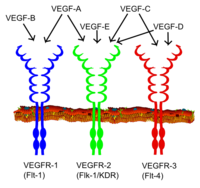
Photo from wikipedia
OBJECTIVE MicroRNA (miR)-340-5p has been identified to play a key role in several cancers. However, the function of miR-340-5p in skin fibroblasts remains largely unknown. METHOD Gain of function was… Click to show full abstract
OBJECTIVE MicroRNA (miR)-340-5p has been identified to play a key role in several cancers. However, the function of miR-340-5p in skin fibroblasts remains largely unknown. METHOD Gain of function was used by infecting the normal skin fibroblast cells with lentivirus carrying a 22 bp miR-340-5p. Cell proliferation was detected by CCK-8 assay. To uncover the mechanisms, mRNA-seq was used. Differentially expressed mRNAs were further analysed by gene ontology and KEGG pathway. The protein levels were analysed by western blot. Dual luciferase reporter assay was used to detect the direct binding of miR-340-5p with the 3'UTR of Kruppel like factor 2 (KLF2). RESULTS MiR-340-5p lentivirus infection suppressed normal skin fibroblast proliferation. The mRNA-seq data revealed that 41 mRNAs were differentially expressed, including 22 up-regulated and 19 down-regulated transcripts in the miR-340-5p overexpression group compared with control group. Gene ontology and pathway analysis revealed that miR-340-5p overexpression correlated with macromolecule biosynthetic process, cellular macromolecule biosynthetic process, membrane, and MAPK signaling pathway. Bioinformatics analysis and luciferase reporter assays showed that miR-340-5p binds to the 3'UTR of KLF2. Enforced expression of miR-340-5p decreased the expression of KLF2 in normal skin fibroblasts. Overexpression of KLF2 restores skin fibroblast proliferation in miR-340-5p overexpression group. CONCLUSION This study demonstrates that miR-340-5p may suppress skin fibroblast proliferation, and possibly through targeting KLF2. These findings could help in the understanding the function of miR-340-5p in skin fibroblast. And miR-340-5p could be a therapy target for preventing scarring.
Journal Title: Current pharmaceutical biotechnology
Year Published: 2019
Link to full text (if available)
Share on Social Media: Sign Up to like & get
recommendations!